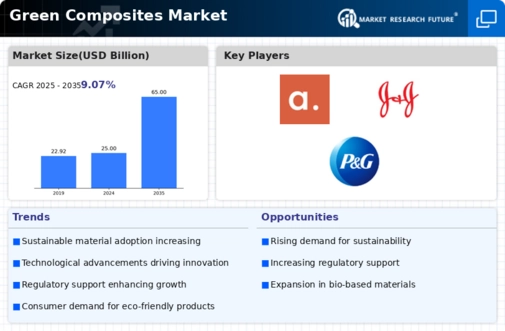Market Trends
Key Emerging Trends in the Green Composites Market
This reflects that the Green Composites industry is currently experiencing significant trends characterized by changes in the material science & engineering landscape. These materials made from natural fibers such as hemp or kenaf stalks combined with bio-degradable resins or soybean proteins can partially replace synthetic thermosetting composites used today; these are known as "green composites" or "bio-composites". One key trend is the increasing adoption of green composites in the automotive industry. Again, there has been a growing demand for green composites from construction and building materials companies operating worldwide. The usage of eco-friendly decking solutions made from renewable wood fibers instead of chemically treated 2-by-6 lumber could help prevent further deforestation, especially in tropical rainforests where most logging operations result in permanent land degradation due to typically high levels of rainfall throughout the year. The commitment within the construction industry towards green buildings and environment-friendly building materials drives demand for green composites over traditional construction materials having higher carbon footprints. Additionally, there have been advancements in formulations aiming at improving performance characteristics and widening application areas within this sector (Green Composites). Manufacturers are now investing more in research & development to develop green composites with enhanced mechanical properties such as tensile strength, fire resistance attributes, and durability. The motivation behind this trend stems from biomaterials that can match up to composites in terms of performance but have sustainability benefits. On the regulatory front, there is an increasing focus on sustainability and environmental impact issues in the manufacturing industry, which encompasses composites. Manufacturers are modifying their formulations to meet recycling requirements, biodegradability specifications, and overall ecological safety. This is a reflection of the sector's commitment to sustainable practices as well as the stringency of regulations governing material usage. Moreover, demand for green composites has been increasing across diverse markets triggered by geographic expansion tendencies, especially within emerging economies. Rapid industrialization and urbanization in areas like Asia-Pacific are driving demand for green composites across several applications, including automotive, construction, and consumer goods sectors. Such regions provide a growing market for manufacturers to position themselves well and address escalating demands from different industries. In terms of technological advancements, the Green Composites market is experiencing innovations in manufacturing processes to enhance efficiency and reduce environmental impact. This involves the deployment of advanced processing methods, the use of natural fibers obtained from sustainable sources, and the development of improved life-cycle assessment (LCA) based composite materials. The trend reflects a broader industry push towards green chemistry and sustainable practices in material manufacturing.






Leave a Comment